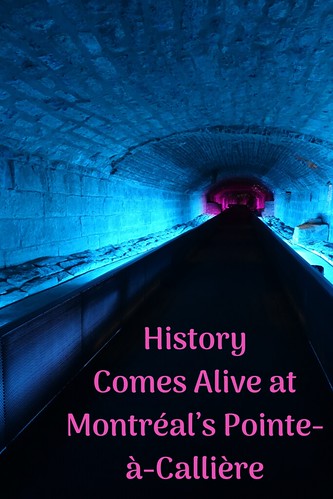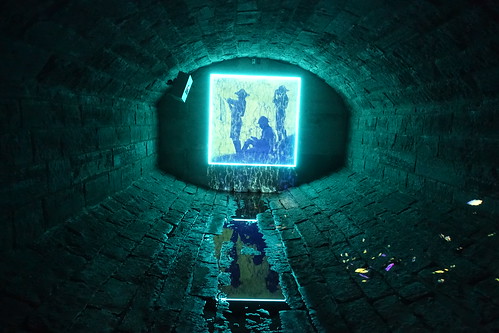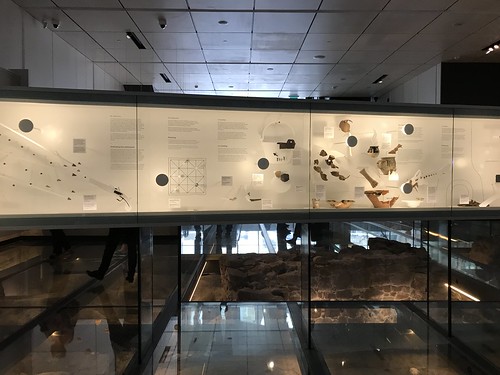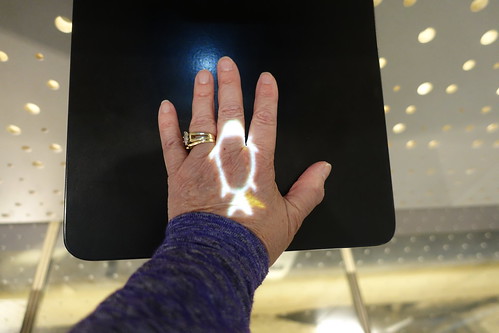History Comes Alive at Montréal’s Pointe-à-Callière
Like many other city museums around the world, Montréal’s Pointe-à-Callière (the Montréal Archeology and History Complex) is temporarily closed, but not forgotten. Stories like this one share tips and information for future adventures. If you are planning to visit Montréal and love history, I recommend including Pointe-à-Callière, the largest and most visited museum in Montréal, in your future travel plans.

Most would agree that first-hand experiences are far superior to secondary sources. Constructing a museum on “the site where Montréal was born” offers a unique opportunity to understand the city’s heritage from the time of the First Peoples to modern times. While strolling the historic district of Old Montréal, I observed the compatibility between the museum’s stone façade structure and the adjacent 19th-century buildings. Before entering, our guide directed our attention to the top of the building, where an alcove houses a bronze bell commemorating the 375th anniversary of the city. The original bell marked time during the day, promoted Mass times and warned the townspeople of impending Iroquois attacks.

Commemorative Bell
After the museum’s 1992 opening that coincided with the city’s 350th anniversary, scientists started to excavate an adjacent site. The archeological digs uncovered approximately 350,000 artifacts and ecofacts. A few years ago, the museum chose to include the unearthed fragile ruins of Fort Ville-Marie and the city’s collector sewer inside the museum and to showcase a portion of the newly retrieved artifacts.
Both landmarks have historical value. Fort Ville-Marie was built in 1642, near the intersection of the St. Lawrence and the Petite Rivière Saint-Pierre, as a mission to convert indigenous people. Records indicate that 49 men and women left New France in 1641 to settle in this region. As the city grew, the inhabitants caused the Petite Rivière Saint-Pierre to become an open sewer funneling the city’s waste to the St. Lawrence. Almost two hundred years later, the Petite Rivière Saint-Pierre was transformed into an underground collector sewer built out of stone that was eventually abandoned in 1989.
Six separate exhibits are part of the museum’s permanent collection—the Multimedia Show, Crossroads Montréal, 1701—The Great Peace of Montréal, Building Montréal, the Memory Collector, and Where Montréal Began.
Multimedia Show
In the Hydro-Quebec Multimedia Theater, I watched a 17-minute presentation highlighting Montréal’s history projected on massive panels. Audio and visual technology overwhelmed my senses as a series of narrators pieced together Montréal’s early history and subsequent milestones. When I walked into the building, I had a minimal understanding of the region’s history. I found this short multi-sensory exhibit showcasing significant events and people to be both informative and entertaining.

Crossroads Montréal
In this area, I saw the ruins of Ville-Marie’s first Catholic cemetery dating back to 1643. I also learned facts about the First Nations people who inhabited the region before the French arrived.

Foundation of the Royal Insurance Building in the Crossroads Exhibit
1701—The Great Peace of Montréal
A turning point in the region’s history was the signing of the Great Peace Treaty of Montréal in 1701. Louis-Hector de Callière, governor of New France, along with representatives from 39 aboriginal nations from around the Great Lakes and the tributaries of the Mississippi River signed the treaty at the recently erected palisade. Previous skirmishes with the indigenous people had negatively impacted the growth of New France. This agreement allowed the settlers to expand from the Gulf of the St. Lawrence to the Gulf of Mexico.

Building Montréal
Oversized panels detailing facts and significant dates, along with artifacts, offered additional information about Montréal’s rich history. Anyone wanting a deep dive into Montréal’s history could easily spend a considerable amount of time reading the posted signs and looking at the items on display.


Memory Collector
From the basement of the Eperon Building, I walked through a 110-meter segment of the former collector sewer, the oldest structure of its kind in Canada (built between 1832 and 1838), to reach the Fort Ville-Marie site, the first settlement of Montréal’s founders.
I was intrigued by the multi-media presentation called Memory Collector. Moment Factory, a local company, created a continuous projection of colors lining the stone cavern with a corresponding sound show. An abandoned sewer was completely transformed by modern technology. As I came closer to the end of the tunnel, I was able to distinguish the archival images digitally displayed.

Where Montréal Began
In 2017, this newer pavilion commemorated the 375th anniversary of Montréal’s founding. This spacious, modern room has a glass floor. I peered into the illuminated ruins of Fort Ville-Marie and the former Callière residence.

Glass Floor and artifacts with descriptions Inside Where Montreal Began
The archeological ruins are protected by a custom microclimate that controls temperature, humidity, and airflow. This technology preserves the ruins while allowing visitors visual access.
In this room, I was also able to interact with the Circle of Peace exhibit by placing my hand in a designated spot where an illuminated image would impart one of the pictograms used by one of the indigenous chiefs who signed the Peace Treaty.

Circle of Piece exhibit showing pictogram
My two hours inside the museum offered a superb introduction to Montréal’s history. The multi-media presentations kept me engaged throughout my visit and will undoubtedly appeal to children with limited attention spans. Situating a museum at a historical site is a definite plus. Young and old will benefit from the collaborative efforts of scientists and museum designers.
Until the museum reopens, potential visitors can get a sneak peek of the exhibits by taking a few virtual tours on the website.
Sandy Bornstein, the History Comes Alive Through Travel Editor for Wandering Educators, has visited more than 40 countries and lived as an international teacher in Bangalore, India. Sandy’s award-winning book, May This Be the Best Year of Your Life, is a resource for people contemplating an expat lifestyle and living outside their comfort zone. Sandy writes about Jewish culture and history, historical sites, family, intergenerational, and active midlife adventures highlighting land and water experiences.
Sandy Bornstein visited Montréal during a media trip arranged by DQMPR in conjunction with the Travel Classics International 2018 Travel Writers Conference in Montréal.
All photos courtesy and copyright Sandy Bornstein


















